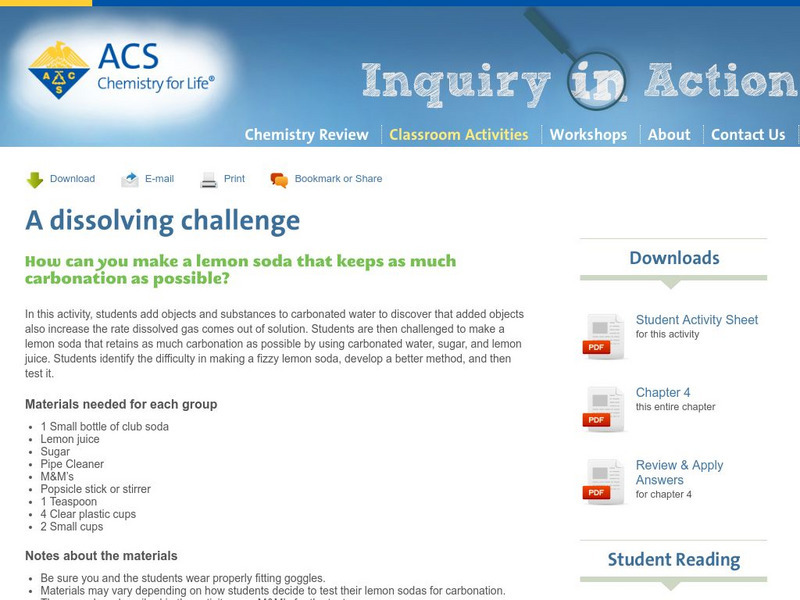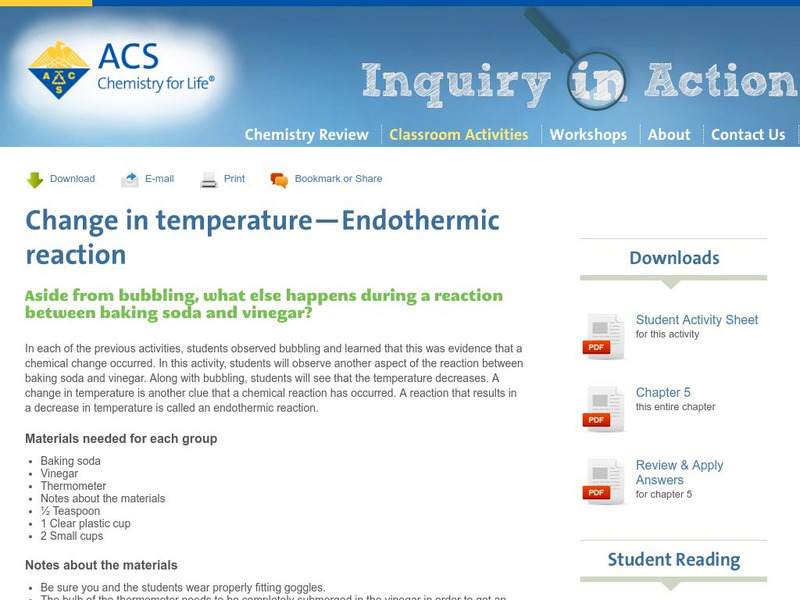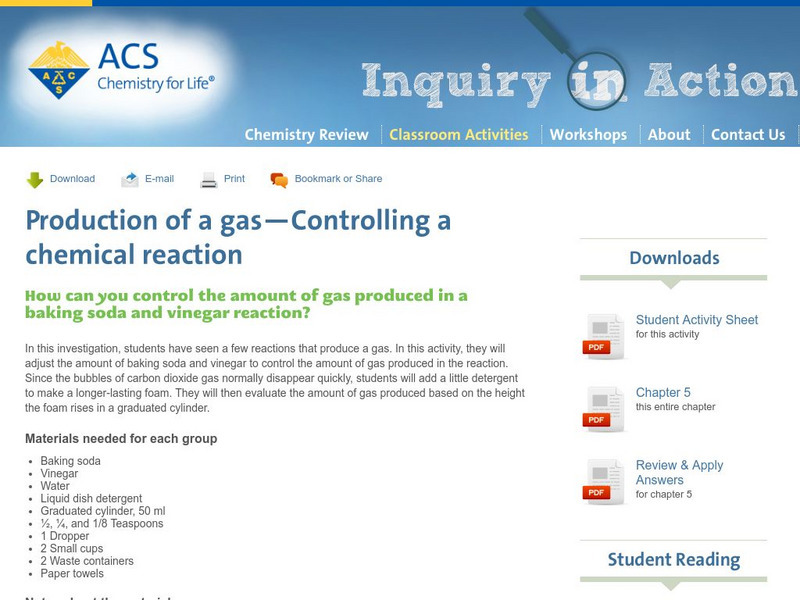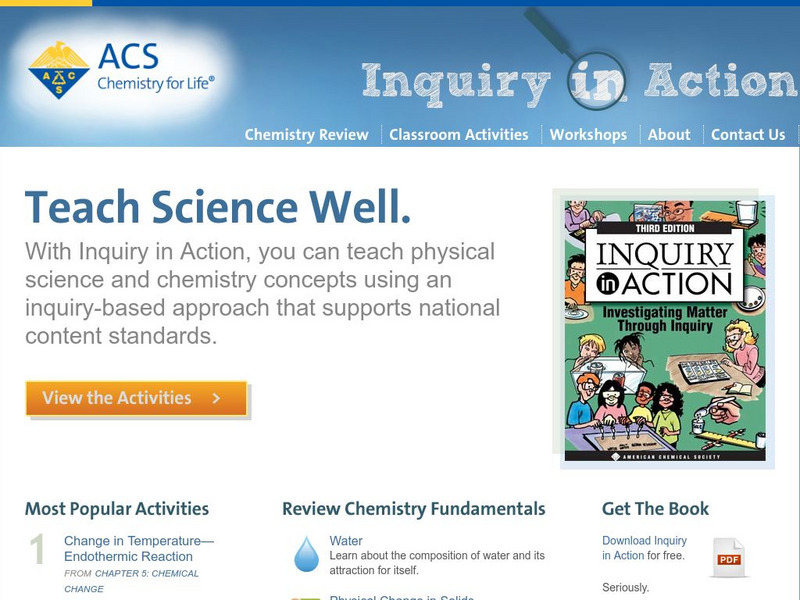American Chemical Society
Inquiry in Action: Using Color to See How Liquids Combine
An activity where students use the characteristics of liquids when they combine with water to tell the differences between them. Activity includes both student and teacher instructions.
American Chemical Society
Inquiry in Action: Using the Combining Test to Identify the Unknown Liquids
Learn how you can identify unknown liquids by knowing the characteristic way each liquid combines with water in this activity. Lab experiment includes teacher and student instructions.
American Chemical Society
Inquiry in Action: Dissolving a Substance in Different Liquids
This activity investigates the question of whether colored sugar dissolves at the same rate in water, vegetable oil, and alcohol. This lesson includes teacher information and student activity sheet.
American Chemical Society
Inquiry in Action: Temperature Affects Dissolving
Answer the question of whether cocoa mix dissolves in hot water or cold water in this activity. Help students see how temperature affects the rate at which solids dissolve. This lesson includes teacher and student instructions.
American Chemical Society
Inquiry in Action: Dissolving Different Liquids in Water
This activity will have students experimenting with whether all liquids dissolve in water. Activity includes both teacher and student instructions.
American Chemical Society
Inquiry in Action: Temperature Affects the Solubility of Gases
Learn about the effect of temperature on the solubility of gases in this lab activity. This lab activity includes instructions for both student and teacher.
American Chemical Society
Inquiry in Action: A Dissolving Challenge
A challenge where students are asked to make a lemon soda that holds as much carbonation as possible by using three ingredients. This lab experiment includes a demonstration, challenge, and mini-report. Also, this lab experiment includes...
American Chemical Society
Inquiry in Action: Powder Particulars
In this activity, students will learn how to use reactivity properties of substances to distinguish between similar-looking substances. This lab experiment includes student and teacher information sheets.
American Chemical Society
Inquiry in Action: Exploring Baking Powder
An activity that allows students to discover the active ingredients in baking powder by studying chemical change. Lab activity includes both teacher and student instructions.
American Chemical Society
Inquiry in Action: Change in Temperature: Endothermic Reaction
In this activity, students will observe another aspect of a chemical change which is a change in temperature. In this reaction, students will experiment with an endothermic reaction.
American Chemical Society
Inquiry in Action: Production of a Gas: Controlling a Chemical Reaction
Observe reactions that produce gases in this lab activity! Students observe chemical changes as they evaluate the amount of gas produced. This lab activity includes both student and teacher instruction sheets.
American Chemical Society
Inquiry in Action: Change in Temperature: Exothermic Reaction
Students will observe an exothermic reaction in this activity where they add calcium chloride to a baking soda solution. This increase in temperature is due to the chemical change that has occurred.
American Chemical Society
Inquiry in Action: Neutralizing Acids and Bases
A lab activity where students will neutralize and acidic solution with a base and a basic solution with an acid by using their knowledge of a red cabbage indicator. This site includes teacher and student instruction for the lab activity...
American Chemical Society
Inquiry in Action: Comparing the Amount of Acid in Different Solutions
Students will complete a procedure to find the solution that has the greatest amount of acid by comparing the amount of the acids in different solutions. This lab activity compares the amount of acid in differents solutions in a...
American Chemical Society
American Chemical Society: Inquiry in Action: Teach Science Well
Online textbook reviews fundamentals of chemistry and physical science via slideshow presentations, notes, and videos. Materials for classroom activities engage students in inquiry-based, hands-on investigations covering molecular...
American Chemical Society
American Chemical Society: Inquiry in Action: Teach Science Well
Online textbook reviews fundamentals of chemistry and physical science via slideshow presentations, notes, and videos. Materials for classroom activities engage students in inquiry-based, hands-on investigations covering molecular...
American Chemical Society
Middle School Chemistry: Lesson Plans: Can Gases Dissolve in Water?
An activity through which students learn why gas is able to dissolve in water, and how heat affects the solubility of a gas in a liquid.
American Chemical Society
Middle School Chemistry: Lesson Plans: Why Does Water Dissolve Salt?
Students use their own model of a salt crystal and water molecule to show how water dissolves salt. Then, they relate their observations to the structure of salt, water, and alcohol on the molecular level.
American Chemical Society
Middle School Chemistry: Lesson Plans: Using Dissolving to Identify an Unknown
Learners first observe a solubility test between salt and sugar. Next, they design their own solubility test with four known crystals and an unknown to discover the identity of the unknown.
American Chemical Society
Middle School Chemistry: Lesson Plans: Using Chemical Change to Identify Unknown
Students observe reactions of liquids with different known powders in this lesson. Unknown powders are then identified using characteristic chemical changes.Site includes a procedure, teacher instructions, and video instruction.
American Chemical Society
Middle School Chemistry: Lesson Plans: Surface Tension
Students observe and investigate why water has a strong surface tension.
American Chemical Society
Middle School Chemistry: Lesson Plans: Forming a Precipitate
Students investigate the concept of a precipitate by combining two clear, colorless solutions that produce a solid.
American Chemical Society
Middle School Chemistry: Controlling Amount of Products in a Chemical Reaction
Students analyze the chemical equation for the reaction between vinegar and baking soda. They observe that the gas produced in the reaction is also part of the products of the written chemical equation.
American Chemical Society
Middle School Chemistry: What Is Density?
Calculate the density of cubes made of different materials to determine what type of material it contains. Using this information explain that the size, mass, and arrangement of the atoms or molecules of a substance determines its density.


















